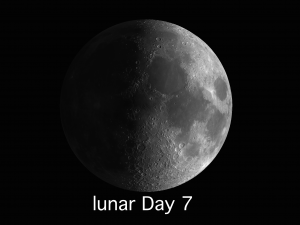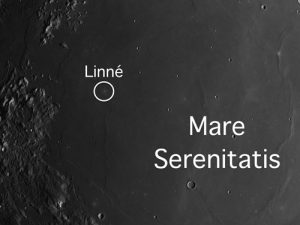The week of June 6-June 12 takes us from lunar Day 2 to the beginning of Day 8. Toward the end of the week is the most rewarding time for observing the Moon. This week we will highlight the crater Linné.
• Linné: [NE/G11] Linné is a simple, relatively young crater with an interesting history. It is only 1.5 miles in diameter (about 1.3 arc-seconds at the average distance of the Moon), which makes it about twice the size of Meteor Crater in Arizona. Linné is surrounded by very light-colored material, and, because its appearance changes so much with different angles of illumination, this was  once taken as evidence that the Moon was not a totally dead place. In 1866 it was erroneously reported that Linné had vanished. The idea caught on and was cited as proof that the Moon was still geologically active. Observe Linné through the Full Moon and see if you can convince yourself (if you didn’t know better) that Linné could disappear.
once taken as evidence that the Moon was not a totally dead place. In 1866 it was erroneously reported that Linné had vanished. The idea caught on and was cited as proof that the Moon was still geologically active. Observe Linné through the Full Moon and see if you can convince yourself (if you didn’t know better) that Linné could disappear.
OF ADDITIONAL INTEREST THE WEEK OF JUNE 6-12:
On Tuesday the Eskimo Nebula will be just about 7° to the right of the Moon. It’s a type of dying star called a planetary nebula and will resemble our Sun in about five billion years when it goes through its death throws.
Look at the star in the bend of the handle of the Big Dipper. This is Mizar. Look closely and just kissing close to Mizar (on the side facing Vega) is tiny Alcor. Contrary to what was believed up to then, in 2009 Alcor and Mizar were discovered, by two independent teams of scientists, to be a true binary system. It is the only binary that you can see with the naked eye. A telescope will reveal Mizar also to be double, so it is in fact a triple star!
======================
It is highly recommended that you get a copy of Sky and Telescope’s Field Map of the Moon, the very finest Moon map available for use at the telescope. It is available for $10.95 at www.skyandtelescope.com and on Amazon. All features mentioned in this blog will be keyed to the grid on the Field Map and will look like this: Plato: [NW/D9]
Credits:
Courtesy of Gray Photography of Corpus Christi, Texas
Lunar photos: NASA / USGS / BMDO / LROC / ASU / DLR / LOLA / Moon Globe. Used by permission
- Rupes Cauchy: A Best Known Fault on the Moon - July 22, 2024
- Moon Crater Schickard – Crater Floor has Stripes - July 15, 2024
- Moon Craters Langrenus and Vandelinus - July 8, 2024